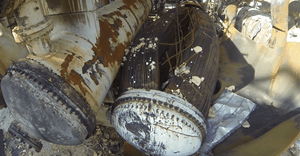Feb 06,2017– The U.S. Chemical Safety Board (CSB) released a safety video of its investigation of the June 13, 2013 explosion and fire at the Williams Olefins Plant in Geismar, Louisiana, which killed two workers and injured an additional 167. The deadly explosion and fire occurred when a heat exchanger containing flammable liquid propane violently ruptured. The CSB says that an “ineffective PSM” program was the cause of the accident. There was efefctively no relief valve on the heat exchanger that burst (there was a relief valve but was completely isolated from the heat exchanger piping!) A well conducted HAZOP Study should have evaluated this deviation, but was apparently not done.
The CSB’s newly released 12-minute safety video entitled, “Blocked In,” includes a 3D animation of the explosion and fire as well as interviews with CSB investigator Lauren Grim and Chairperson Vanessa Allen Sutherland. The video is based on the CSB’s case study on the Williams incident and can be viewed on the CSB’s website and YouTube.
Chairperson Sutherland said, “Our investigation on the explosion at Williams describes an ineffective process safety management program at the plant at the time of the incident. We urge other companies to incorporate our recommendations at their facilities and to assess the state of their cultures to promote safety at all organizational levels to prevent a similar accident. ”
The CSB’s investigation found many process safety management program deficiencies at Williams, which set the stage for the incident. In particular, the CSB found that the heat exchanger that failed was completely isolated from its pressure relief valve.
In the video, Investigator Lauren Grim said, “When evaluating overpressure protection requirements for heat exchangers, engineers must think about how to manage potential scenarios, including unintentional hazards. In this case, simply having a pressure relief valve available could have prevented the explosion.”
The CSB investigation concluded that in the twelve years leading to the incident, a series of process safety management program deficiencies caused the heat exchanger to be unprotected from overpressure. As revealed in the investigation, during that time Management of Change Reviews (MOC for short), Pre-Startup Safety Reviews, and Process Hazard Analyses (PHA for short), all failed to effectively identify and control the hazard. In addition, the CSB found that Williams failed to develop a written procedure for activities performed on the day of the incident, nor did the company have a routine maintenance schedule to prevent the operational heat exchanger from needing to be shut down for cleaning.
Finally, the video describes CSB’s recommendations made to the Williams Geismar plant which encourages similar companies to review and incorporate into their own facilities. These include:
– Conduct safety culture assessments that involve workforce participation, and communicate the results in reports that recommend specific actions to address safety culture weaknesses
– Develop a robust safety indicators tracking program that uses the data identified to drive continual safety improvement
– And perform comprehensive process safety program assessments to thoroughly evaluate the effectiveness of the facility’s process safety programs.
“Managers must implement and then monitor safety programs and encourage a strong culture of safety to protect workers and the environment,” Chairperson Vanessa Allen Sutherland said,
For more information about the accident and subsequent investigation, please visit www.csb.gov.
